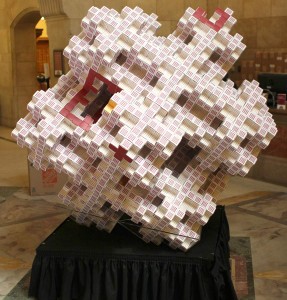Fractal art structure debuts at Doheny
In the lobby of Doheny Memorial Library stands the one and only Mosely Snowflake Sponge, the world’s first three-dimensional origami representation of the icy fractal. Hand-built from nearly 50,000 cardinal-and-gold folded business cards, this exhibit, best described as a fusion of interdisciplinary elements, opened Thursday. The structure will officially be making its home at Doheny through this December.

Communal art · Made up of nearly 50,000 business cards, the structure reflects the collaborative efforts of the USC community. – Austin Vogel | Daily Trojan
The snowflake exhibit, modeled after a fractal structure recently discovered by Jeannine Mosely, is the six-month-long labor of love for curator and USC Libraries Discovery fellow Margaret Wertheim.
“The idea of this project was to [create] something that was an intersection of mathematics, art and engineering,” Wertheim said. “What I think people should get is that art can be combined with mathematics. We often think, in our society, that the arts and sciences are very separate, but here’s an artistic project that is also a mathematical project.”
And as it turns out, fractals are the perfect combination of such elements. As Wertheim pointed out, they are found “in the way lightning forks or the way earthquakes strike through rock, the shape of coastline, cauliflower, clouds, the branching structure of trees, veins.” Bearing a self-similarity property, fractals, like the Mosely Snowflake Sponge, exist in non-whole-number dimensions — a fact that surprised many disbelieving mathematicians before the early 20th century, according to Wertheim.
Spanning six months, from February to August, the project first took root in an exchange between Wertheim and the USC Libraries, which expressed interest in developing a work that would combine seemingly disparate fields of study. Collaboration with Wertheim followed, inspiring a project with Mosely, the artist who dreamed up and designed the entire exhibit.
Of the initial decision to begin the project, Wertheim remarked, “[USC Libraries] were very bold, daring and brave, because [the project] turned out to be more complicated [than] any of us ever imagined when we first started. We didn’t quite realize when it began, how much work it would be or what a complicated object this thing was. We have all really had a journey of discovery.”
Yet the exhibit encompasses more than a partnership between just Wertheim, Mosely and the libraries. It is the work of art showcasing the combined efforts of a community — more than 300 USC students and faculty, neighborhood K-12 students and other volunteers.
“When you have that many cards, I don’t see how anyone can do it on their own,” Wertheim said.
At origami workshops across campus set up in the first few months, students from all fields of study learned the art.
Junior psychology major Leah Singerman and sophomore neuroscience major Maurae Baker were among the many contributors. As workers at Doheny for the past summer, Baker and Singerman spent free time folding thousands of business cards, constructing cubes and building modules while simultaneously lighting newfound passion for the art of origami.
“It’s so interesting and almost shocking how you don’t realize what you can do just by folding business cards,” Singerman said. “We would work on it in the lobby during the day, and anyone who was walking through the library would stop and ask, ‘What is this?’ … Just from doing that, we got so many different types of people involved — from little kids folding the cards to mathematically advanced people making modules all by themselves.”
Baker brought her origami interest beyond library walls.
“I took my dad’s business cards and started doing the same thing, and he was like, ‘This is awesome!’” she said. “So I built him a mini-model. It was cool because we didn’t use any glue; it was just with paper.”
Nearby K-12 students poured in time as well. Through USC’s Neighborhood Academic Initiative, geometry teacher Mr. Michael Laska of James A. Foshay Academy brought over two large groups of nearly 100 ninth graders, giving them an opportunity to see their textbooks’ three-dimensional figures on a grander scale.
“We were studying three-dimensional geometry, and this just happened to be perfect timing,” said Laska. “It allowed them a lot more freedom than being restricted to just coming up with something everybody makes in class … I think most kids didn’t even know what origami was before this project, this got them really interested.”
This exhibit has been viewed as a community art project and an expression of origami. It has also been seen as an object of mathematics as well as a fusion of the art, math and engineering.
But, there’s one more facet left, mirrored in the cardinal-and-gold pattern of the 50,000-business-card cubes and captured in the words of Baker.
“The exhibit is a celebration of USC and all that it has to offer,” she said. “I can’t wait to see the reactions of everyone who hasn’t seen it yet.”
